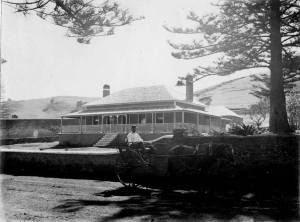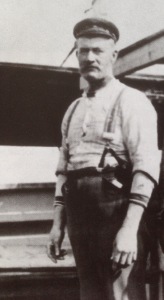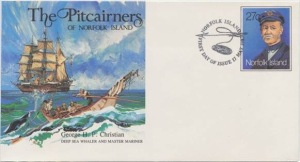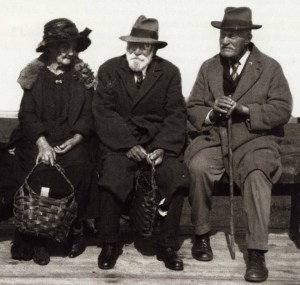 http://www.ebay.com/itm/Bronze-Nail-recovered-from-William-Blighs-H-M-S-Bounty-EXCESSIVELY-RARE-/151761006623?hash=item2355a9301f
http://www.ebay.com/itm/Bronze-Nail-recovered-from-William-Blighs-H-M-S-Bounty-EXCESSIVELY-RARE-/151761006623?hash=item2355a9301f
A few weeks ago Pitcairn and Norfolk Islands Society posted on Facebook about a bent bronze sheathing nail that is being offered for sale on eBay for $US5,250. The seller included a 1971 letter of provenance from a staff member of the National Geographic Society who says he recovered the nail at a depth of some 30 feet in 1957 from the bottom of Bounty Bay at Pitcairn Island. The letter states that the “excessively rare” nail “is from the remains of the Bounty” and was used to fasten copper sheathing to the hull below the waterline. To further authenticate the origin of the nail, the writer also states that other larger items on the site were marked with the “Broad Arrow, symbol of British Government ownership”.
When Parkins Christian gave my great grandmother the marlin spike, also marked with the broad arrow, he was trying to save what was left of the Bounty-Pitcairn heritage from just such speculative collecting. He would have been amazed, if not horrified, to think a bent bronze nail was worth more than $5000 because of its possible connection with the famous ship his great-grandfather sailed to Pitcairn Island in 1790. Certainly today it is hoped that the site is protected from ‘Bounty hunters’ although it may not have been in 1957.
For the descendants of the mutineers, the legacy of the events on the Bounty seemed to be difficult to escape. In his 1967 history of the Charles W Morgan, the 1841 whaling ship that I sailed on in 2014 and that Parkins served on for 20 years as First and Second Mate, Edouard A. Stackpole speculated that the reason Parkins never became a whaling ship’s captain was because of the actions of both his great-grandfathers. Everywhere he went, his connection with Fletcher was always part of his story as told by others. The fact that he never told the Bell children might indicate that this wasn’t the way he wanted to define himself. So who was this man who links Pitcairn, Norfolk Islands, the Bounty mutiny, the American, NZ and Australian whaling industry and maritime history, the Charles W Morgan and my ancestors’ life on Sunday (Raoul) Island? Who was this man whose legacies are beautifully crafted wooden and whalebone artefacts, a marlin spike and photograph and the memories and stories others told of him?

The Pitcairners 1857 Norfolk Island. George Parkyn is the small boy on the left (courtesy Norfolk Island Museum)
He was born George Henry Parkin Christian on Pitcairn Island on 16 October, 1853. He was the fifth child and fourth son of Isaac Christian (Fletcher’s grandson) and Miriam Young, the granddaughter of Edward Young. Parkins was the fifth of sixteen children, and the last one to be born on Pitcairn. His next younger brother Reuben Denison Christian was born on the voyage to Norfolk Island on the Morayshire which had left Pitcairn Island on 2 May 1856 carrying 194 people for resettlement on Norfolk Island. A photograph of some of the women settlers taken in 1857 identifies “George Parkyn Christian”, dressed in what appears to be a smock or dress, half-hiding behind Rebecca Evans, his mother Miriam standing at the back among women with the familiar surnames of Nobbs, Young, Quintal and Evans.
 No.10 Quality Row. Built in 1844, it became the family home of Isaac and Miriam Christian, George Parkin’s parents, after the Pitcairn Islanders arrived in 1856. It is now the Norfolk Island Museum (courtesy Norfolk Island Museum)
No.10 Quality Row. Built in 1844, it became the family home of Isaac and Miriam Christian, George Parkin’s parents, after the Pitcairn Islanders arrived in 1856. It is now the Norfolk Island Museum (courtesy Norfolk Island Museum)In 1874 he married Augusta Ross Adams who had also been born on Pitcairn, daughter of Jonathan Adams and Phoebe Quintal. Mutineers John Adams, Edward Young, William McCoy, Matthew Quintal and their Tahitian wives were her great grandparents. They had eight children born between 1875 and 1889. His wife died of cancer aged 46 in August 1899. Interestingly, two of the children’s names reflect Parkins’ link with the New Bedford whaling industry and the ships’ captains; this may be a coincidence of course. Howland was born in 1883 (a Howland company had been a past manager of the Charles W Morgan and a James Howland 4th Mate, on the Charles W Morgan, drowned in 1882). His youngest son James Sherman Christian was born in 1889 (Capt. Sherman was captain of the Canton). Parkins served on board the Charles W Morgan for at least 12 of the 14 voyages between 1893 and 1913, mostly as boat steerer or second mate.
 From Charles W. Morgan by J.F. Leavitt (Museum of America and the Sea, Mystic Seaport, Connecticut)A photograph of him taken on board either 30th (1904) or 31st (1906) voyage shows a tall, strong, well-built man with an intense gaze.
From Charles W. Morgan by J.F. Leavitt (Museum of America and the Sea, Mystic Seaport, Connecticut)A photograph of him taken on board either 30th (1904) or 31st (1906) voyage shows a tall, strong, well-built man with an intense gaze.A photograph of him taken on board either 30th (1904) or 31st (1906) voyage shows a tall, strong, well-built man with an intense gaze.
Bessie and the Bell children were not the only children who hero-worshipped Parkins. Captain Earle’s three year old son Jamie accompanied his parents on the 1902 voyage of the Charles W Morgan and in later life Jamie remembered that he idolized “big George Christian”, second mate, who made toys for him including a small sailing boat on the deck, and spent much of his off-watch time with the boy. How much time he spent with his own 8 children, given his voyaging, is uncertain. While he was away whaling on the Costa Rica Packet in 1890, his 4 year old daughter Mary died of an abdominal tumour.
 A first day cover from Norfolk Island 1983
A first day cover from Norfolk Island 1983My research into Parkins Christian continues. Establishing an accurate timeline for his peripatetic life has proved challenging and earlier books on the whaling industry are vague and often contradictory. I have him as a seaman on the schooner Ariel (NZ) in 1872 when he saved a young girl from drowning when she fell overboard, the Robert Towns and the Costa Rica Packet (Sydney), the Othello (Hobart and NZ), American whaling barks Cape Horn Pigeon, Canton, California, Charles W Morgan and the schooner A.M. Nicholson and finally the Resolution (Norfolk island). The Royal Humane Society (London) awarded him a silver medallion for bravery following the Ariel rescue when he was just 19. He captained the Resolution at 72. He sailed and whaled throughout the Pacific, the South Indian Ocean, the Japan Seas, the Atlantic, the Ochotsk Sea and the Arctic. There are conflicting sources and stories which add to the confusion. But his will be a story worth the telling.
 The Elders – George Parkins is on the right. (Courtesy Norfolk Island Museum).
The Elders – George Parkins is on the right. (Courtesy Norfolk Island Museum).